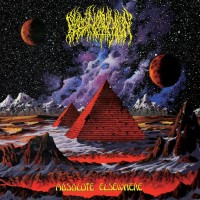Neurotech - Symphonies II review
| Band: | Neurotech |
| Album: | Symphonies II |
| Style: | Industrial metal, Symphonic metal |
| Release date: | March 04, 2022 |
| A review by: | musclassia |
01. The Prophetic Symphony
02. The Seraphic Symphony
03. The Draconic Symphony
04. The Messianic Symphony
Colors II, now Symphonies II: just like movies, all people want in music today is sequels, I hear disgruntled musical elitists groan.
Neurotech was a prolific project during its initial lifespan, so it’s not surprising that the first post-hiatus album, Solace, is followed so swiftly by another full-length record; however, Wulf’s brought out the big guns this time around. Symphonies, a collection of four long-form compositions (all over 10 minutes) that took the building blocks of the Neurotech sound around the middle of last decade and pushed them to more epic and grandiose shores, was one of the most notable releases from the first period of Neurotech’s existence. Those symphonies were released on an annual basis from 2013 onwards, with the fourth one released in a compilation with the others in 2016; for Symphonies II, Wulf went for a similar approach, with one song released every month from December 2021 onwards until “The Prophetic Symphony” dropped as part of the Symphonies II compilation in March 2022. This is a follow-up to Symphonies in more ways than one, and that’s cause to be excited.
Symphonies was a collection of tracks that were all over 10 minutes; Symphonies II breaks this mould by containing 4 songs that are 10 minutes exactly. However, it does otherwise represent the same kind of break from the ‘standard’ Neurotech sound. The industrial chugs, serene ambient backdrops and prominent electronics that serve as the core of most of their music are still present, but there’s (unsurprisingly, given the name) a more symphonic feel to the arrangements, with lots of soaring string sounds and other symphonic synth sounds. There’s other differences too; the metallic side goes harder on several occasions than one might expect, with forceful double bass attacks and blasts, while on the flip side, vocals are pretty much entirely absent.
I reviewed Solace last year, and found myself underwhelmed by it, citing underdeveloped metal arrangements, repetitive vocal hooks and shallow arrangements. Symphonies II largely solves most of these issues, thankfully. As already mentioned, there is an absence of vocals, which by its very nature prevents the vocal melodies growing stale. As far as the metal side goes, it feels like a much stronger element this time around; this is mostly thanks to range in the drumming approaches, whether it’s the double bass rolls in “The Prophetic Symphony”, the frantic blasting opening of “The Seraphic Symphony” or the pounding snare in “The Messianic Symphony”. The guitars also have a bit more chance to shine as more than just an amorphous low-end chug, with some neat lead guitar melodies and some clearer, higher-pitched tones for the riffs in “The Messianic Symphony”.
However, for me, probably the strongest way Symphonies II improves on Solace is how purposeful the electronics, symphonic synths and arrangements of them alongside the metallic elements feel in comparison to what I found to be a slightly shallow formula on Solace. “The Prophetic Symphony” is the track I connected with most strongly on Symphonies II; the way that it combines frantic synths and a bouncy keyboard melody with an explosion of blasting about a third of the way through, compared with a delicate, evocative violin melody that sings above a weightier, more percussive chug around the two-thirds mark, shows a strong intelligence of how to merge these elements in distinctive ways as is appropriate for the tone of the song. “The Messianic Symphony” is a track that places the guitars in a slightly more prominent role, and exhibits good interplay between guitar leads, keyboard melodies and electronic motifs.
Symphonies II is the most that I’ve enjoyed a Neurotech record since at least the first Symphonies record; however, I’m not entirely enamoured with it. In terms of concrete complaints I can have with it, I would prefer if the guitars were higher in the mix; they’re doing more interesting things on this album, but there’s too many times where they feel so buried down that it’s hard to decipher what’s actually going on, and it just turns into a low-end chasm of noise. Additionally, as much as I do find there’s a greater number of truly memorable and impactful moments on this record compared to some other recent Neurotech albums, there are a few too many sections that feel a bit ‘style over substance’, featuring flashy, dazzling synth/keyboard moments that don’t make much of an impression; “The Draconic Symphony” was probably the track I felt this most strongly with, as it repeatedly marries blasts with the same laser-speed glittering electronic motif.
Overall, Symphonies II is a nice return back to what was a fairly unique project within the first cycle of Neurotech, and although it’s quite likely going to be another ‘odd one out’ album in the second cycle of Neurotech, it gives me more optimism in what Wulf will be releasing going forward. The approach on the Symphonies records is distinct to the main sound of this project, but I hope some aspects of this are carried over to the Neurotech record, which, given its prolific nature, should be coming pretty soon.
Rating breakdown
| Performance: | 8 |
| Songwriting: | 8 |
| Originality: | 7 |
| Production: | 7 |
Comments
Hits total: 1724 | This month: 13





